Power Operated Maize Dehusker-cum-Sheller
 The machine has a threshing cylinder of 495 x 1460 mm size with peg type drum. It uses centrifugal type blower. There are three round sieves with 12.5 mm size hole in upper sieve, 7 mm in middle sieve and 3 mm in lower sieve. Concave clearance is kept about 50 mm and opening size of concave is 5.1 x 5.1 mm. Cylinder speed is kept at 13.7 m/s. The output of machine varies from 1.7to 2.1 t/h at moisture content from 11.8 to 24.8%. The cleaning and threshing efficiency range 94-99% and 96-98%, respectively. The overall grain losses are from 0.65 to 1.42%. The percent recovery of grain with the machine is 97% as compared to 78.4% in manual threshing. The unit price of equipment is about Rs. 40,000. The cost of operation of this machine is Rs. 500/t against Rs. 1500/t by traditional method. There is a saving of about 60-70% in cost of operation and about 90% in labour as compared to traditional method of dehusking and threshing.
The machine has a threshing cylinder of 495 x 1460 mm size with peg type drum. It uses centrifugal type blower. There are three round sieves with 12.5 mm size hole in upper sieve, 7 mm in middle sieve and 3 mm in lower sieve. Concave clearance is kept about 50 mm and opening size of concave is 5.1 x 5.1 mm. Cylinder speed is kept at 13.7 m/s. The output of machine varies from 1.7to 2.1 t/h at moisture content from 11.8 to 24.8%. The cleaning and threshing efficiency range 94-99% and 96-98%, respectively. The overall grain losses are from 0.65 to 1.42%. The percent recovery of grain with the machine is 97% as compared to 78.4% in manual threshing. The unit price of equipment is about Rs. 40,000. The cost of operation of this machine is Rs. 500/t against Rs. 1500/t by traditional method. There is a saving of about 60-70% in cost of operation and about 90% in labour as compared to traditional method of dehusking and threshing.
Whole Crop Maize Thresher
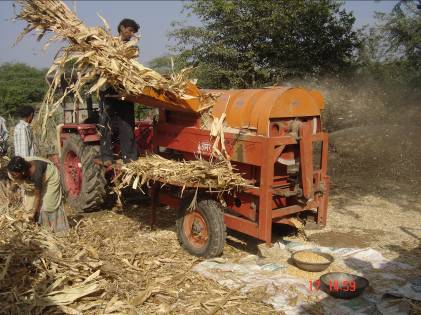 A whole crop maize thresher has been developed for shelling of maize cob and simultaneously converting stalk to chaff. The thresher is designed for 5.5 kW power with spike tooth cylinder having 6-7 bolts per row on periphery. Concave is prepared by placing 8 mm square bars at a spacing of 18 mm. Threshing speed is kept at 620 rpm. The output capacity of whole crop maize thresher is 210 kg/h. The output of grain is observed as 640 kg/h with chaff size of 18 to 52 mm. This chaff is fed to animals and 85% material is consumed in comparison to the whole stalk. The unit price of the machine is Rs. 70,000/-. Moreover, significant saving of Rs. 2000-2100/ha in labour was for detachment of cobs and transportation of crop from field to home.
A whole crop maize thresher has been developed for shelling of maize cob and simultaneously converting stalk to chaff. The thresher is designed for 5.5 kW power with spike tooth cylinder having 6-7 bolts per row on periphery. Concave is prepared by placing 8 mm square bars at a spacing of 18 mm. Threshing speed is kept at 620 rpm. The output capacity of whole crop maize thresher is 210 kg/h. The output of grain is observed as 640 kg/h with chaff size of 18 to 52 mm. This chaff is fed to animals and 85% material is consumed in comparison to the whole stalk. The unit price of the machine is Rs. 70,000/-. Moreover, significant saving of Rs. 2000-2100/ha in labour was for detachment of cobs and transportation of crop from field to home.
Tractor or Electric Motor Operated Multi-crop Thresher for Seed Spices
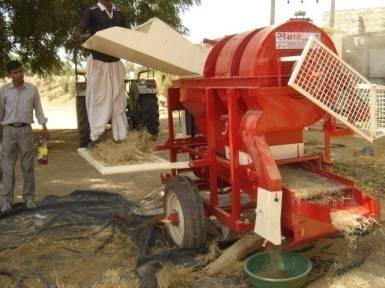 The traditional practice of threshing of seed spices is either by beating on drums or on wooden logs or treading under tractor wheels on mud floors. It requires lots of labour and lot of dust and stone come in during the threshing process and are to be removed manually by hand sieves or cleaning machine in factories reducing the quality of seed spices. Therefore, a tractor/electric motor operated thresher has been developed at MPUAT, Udaipur in collaboration with M/s Makewell Industries, Unjha (Gujarat) and evaluated for threshing of cumin and coriander crops. The drive to power transmission is given by telescoping shaft connected to PTO of tractor. An electric motor of 5.6 kW is mounted on frame so wherever electricity is available, thresher can be used with electric power. The output capacity of thresher is 240-260 kg/h. The unit price of thresher is Rs 70,000.
The traditional practice of threshing of seed spices is either by beating on drums or on wooden logs or treading under tractor wheels on mud floors. It requires lots of labour and lot of dust and stone come in during the threshing process and are to be removed manually by hand sieves or cleaning machine in factories reducing the quality of seed spices. Therefore, a tractor/electric motor operated thresher has been developed at MPUAT, Udaipur in collaboration with M/s Makewell Industries, Unjha (Gujarat) and evaluated for threshing of cumin and coriander crops. The drive to power transmission is given by telescoping shaft connected to PTO of tractor. An electric motor of 5.6 kW is mounted on frame so wherever electricity is available, thresher can be used with electric power. The output capacity of thresher is 240-260 kg/h. The unit price of thresher is Rs 70,000.
High Capacity Multi-crop Thresher
 It is suitable for threshing wheat, maize, sorghum, rice, gram, pigeon pea, soybean, mustard, sunflower, safflower and linseed crops. It consists of spike tooth cylinder, aspirator type blower and sieve shaker. Two top covers, three concaves, three sieves and variable cylinder speeds (7-21 m/s) are provided for threshing different crops. Reciprocating sieve system consists of replaceable set of sieves and screens mounted on oscillating frame. The upper sieve separates chaff bigger than grain while lower screen let the dust and smaller particles than grain pass through thus help in delivering clean grain at main outlet. The grain output capacity is 16-20 q/h for wheat, 8-10 q/h for raya, 6-8 q/h for gram, 4-5 q/h for green gram, 4.0 q/h for moong and 5.0 q/h for guar crops. The machine is operated at the lowest cylinder speed of 300 rpm for moong to minimize the breakage while it is operated at 500 rpm for guar crop. Threshing efficiency, un-threshed grain and visible damage are 98-99%, 1.5-2.0% and 1.0%, respectively. Threshing efficiency and cleaning efficiency are observed to be within the recommended limit. An average total losses are about 5%. The cost of machine is Rs. 70,000/- to Rs. 80,000/ and operating cost is Rs. 250-300/h. The thresher is provided with four wheels made of cast iron for transportation and motor stand to fit the motor on it. It also has provision for attaching universal shaft for operating the thresher by tractor PTO.
It is suitable for threshing wheat, maize, sorghum, rice, gram, pigeon pea, soybean, mustard, sunflower, safflower and linseed crops. It consists of spike tooth cylinder, aspirator type blower and sieve shaker. Two top covers, three concaves, three sieves and variable cylinder speeds (7-21 m/s) are provided for threshing different crops. Reciprocating sieve system consists of replaceable set of sieves and screens mounted on oscillating frame. The upper sieve separates chaff bigger than grain while lower screen let the dust and smaller particles than grain pass through thus help in delivering clean grain at main outlet. The grain output capacity is 16-20 q/h for wheat, 8-10 q/h for raya, 6-8 q/h for gram, 4-5 q/h for green gram, 4.0 q/h for moong and 5.0 q/h for guar crops. The machine is operated at the lowest cylinder speed of 300 rpm for moong to minimize the breakage while it is operated at 500 rpm for guar crop. Threshing efficiency, un-threshed grain and visible damage are 98-99%, 1.5-2.0% and 1.0%, respectively. Threshing efficiency and cleaning efficiency are observed to be within the recommended limit. An average total losses are about 5%. The cost of machine is Rs. 70,000/- to Rs. 80,000/ and operating cost is Rs. 250-300/h. The thresher is provided with four wheels made of cast iron for transportation and motor stand to fit the motor on it. It also has provision for attaching universal shaft for operating the thresher by tractor PTO.
Multi-crop Plot Thresher
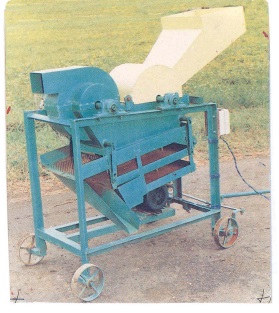 It is suitable for precision threshing samples of wheat, gram, sorghum, soybean, safflower, pigeon pea and pearl millet of field experiments. It consists of a spike tooth cylinder, concave, aspirator blower and sieve shaker. The capacity of this equipment is 3-4 times higher over manual method of threshing crop samples. It has a grain recovery of over 99.5%. It costs Rs. 28,000/- with motor and cost of operation is Rs. 80-130/q.
It is suitable for precision threshing samples of wheat, gram, sorghum, soybean, safflower, pigeon pea and pearl millet of field experiments. It consists of a spike tooth cylinder, concave, aspirator blower and sieve shaker. The capacity of this equipment is 3-4 times higher over manual method of threshing crop samples. It has a grain recovery of over 99.5%. It costs Rs. 28,000/- with motor and cost of operation is Rs. 80-130/q.
Tractor Operated Straw Combine
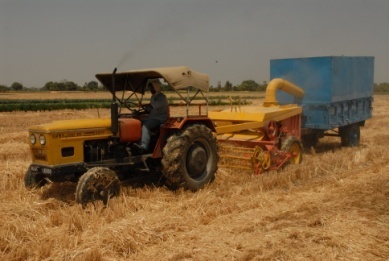 Straw reaper is pulled by a tractor of 34 kW with an attached trolley. Two persons are required for its operation. A straw reaper essentially consists of four main units viz. stubble cutting and collecting unit, feeding unit, straw bruising unit and ‘bhusa’ blowing unit. Two different types of straw bruising mechanisms are commonly used in the existing models of straw combines. These include a spike tooth cylinder and serrated saw type mechanisms. Serrated saw type cylinders are mostly used in the straw combines for bruising. As soon as the attached trolley is completely filled with straw, it is unloaded near the dumping site normally located centrally or in the corner of the field and another trolley is attached. The field capacity of the machine varies from 0.4 to 0.6 ha/h at forward speed from 2.5 to 3.0 km/h. The average width of cut of the machine is 1.90 m. The straw recovery is about 55-60% and depends upon the stubbles height remaining in the field after harvesting by combine. Straw recovery rate varies from 25 to 35 q/ha. The grain collected in pan ranges from 50 to 100 kg/ha with recovery of 40 to 60%. The approximate cost of the machine is Rs 1.50 to 2.00 lakh. The cost of operation is Rs. 1200/ha.
Straw reaper is pulled by a tractor of 34 kW with an attached trolley. Two persons are required for its operation. A straw reaper essentially consists of four main units viz. stubble cutting and collecting unit, feeding unit, straw bruising unit and ‘bhusa’ blowing unit. Two different types of straw bruising mechanisms are commonly used in the existing models of straw combines. These include a spike tooth cylinder and serrated saw type mechanisms. Serrated saw type cylinders are mostly used in the straw combines for bruising. As soon as the attached trolley is completely filled with straw, it is unloaded near the dumping site normally located centrally or in the corner of the field and another trolley is attached. The field capacity of the machine varies from 0.4 to 0.6 ha/h at forward speed from 2.5 to 3.0 km/h. The average width of cut of the machine is 1.90 m. The straw recovery is about 55-60% and depends upon the stubbles height remaining in the field after harvesting by combine. Straw recovery rate varies from 25 to 35 q/ha. The grain collected in pan ranges from 50 to 100 kg/ha with recovery of 40 to 60%. The approximate cost of the machine is Rs 1.50 to 2.00 lakh. The cost of operation is Rs. 1200/ha.
Tree Climber
 In order to harvest coconut and arecanut at faster rate with proper safety, a tree climber has been developed at TNAU, Coimbatore. The climber made of M.S. square pipe consists of two components connected by adjustable belts. The upper component is provided with a seating arrangement and lower component is having provision for holding the foot. The rubber cushioning is provided at the portion of frames, which comes in contact with tree to avoid any damage to tree. By standing on the lower component, the upper component can be moved up or down over the tree. The operator can safely climb a tree of 10 m height in 1.5 min. The cost of operation with tree climber is Rs. 3500/ha as compared to Rs. 5000/ha with conventional system.
In order to harvest coconut and arecanut at faster rate with proper safety, a tree climber has been developed at TNAU, Coimbatore. The climber made of M.S. square pipe consists of two components connected by adjustable belts. The upper component is provided with a seating arrangement and lower component is having provision for holding the foot. The rubber cushioning is provided at the portion of frames, which comes in contact with tree to avoid any damage to tree. By standing on the lower component, the upper component can be moved up or down over the tree. The operator can safely climb a tree of 10 m height in 1.5 min. The cost of operation with tree climber is Rs. 3500/ha as compared to Rs. 5000/ha with conventional system.
Tractor operated banana clump remover
 Banana crop is maintained for two years to get the benefit of two harvests. The crop needs removal of clumps (plants along with root portion) after two years. During the process of removal of the clump, the mother plant along with the rhyzome and side suckers as a whole mass has to be removed so as to prepare the land for the next crop. Manual labourers do this operation using crowbars and spades. A tractor operated banana clump remover has been developed by adopting frame of nine tyne cultivator. Two sub-soiler shanks (100 x 15 x 1000 mm) with shares of size 190 x 40 x 5 mm are fitted to nine tyne cultivator frame at 225 mm spacing. These two sub-soilers work as a fork for removing the banana clump. A deflector is provided to push the soil sideways. The equipment is attached to the 3-point linkage of a 26 kW tractor. The field capacity of machine is 0.5 ha/h. The unit price of clump remover is Rs. 20,000/. The cost of operation with the equipment is Rs 700/ha as compared to Rs. 2000-2500/ha during manual digging of clumps. Thus, there is a saving of Rs. 1300-1800/ha.
Banana crop is maintained for two years to get the benefit of two harvests. The crop needs removal of clumps (plants along with root portion) after two years. During the process of removal of the clump, the mother plant along with the rhyzome and side suckers as a whole mass has to be removed so as to prepare the land for the next crop. Manual labourers do this operation using crowbars and spades. A tractor operated banana clump remover has been developed by adopting frame of nine tyne cultivator. Two sub-soiler shanks (100 x 15 x 1000 mm) with shares of size 190 x 40 x 5 mm are fitted to nine tyne cultivator frame at 225 mm spacing. These two sub-soilers work as a fork for removing the banana clump. A deflector is provided to push the soil sideways. The equipment is attached to the 3-point linkage of a 26 kW tractor. The field capacity of machine is 0.5 ha/h. The unit price of clump remover is Rs. 20,000/. The cost of operation with the equipment is Rs 700/ha as compared to Rs. 2000-2500/ha during manual digging of clumps. Thus, there is a saving of Rs. 1300-1800/ha.
Power Operated Sugarcane Sett Cutter
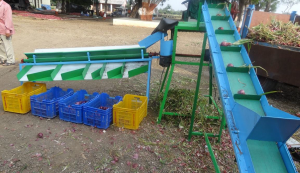
Power operated (0.75 kW, 1440 rpm, single phase electric motor) sugarcane sett cutter has been developed at MPKV, Rahuri. It has four numbers of cutting blades to cut sugarcane setts. The capacity of the developed cutter is 6500 setts/h. The time required to cut setts for one hectare by the developed machine is 2.13 h. The cost of machine, cost of operation and time saving over manual operation are Rs. 75000, Rs. 300/ha and 93%, respectively.
Power Operated Onion Detopper cum Grader
 Presently, detopping and grading of onion in our country are done manually which are very time consuming and labour intensive operations. A power operated onion detopper-cum-grader has been developed at MPKV, Rahuri. The machine consists of feeding mechanism, detopping mechanism and grading mechanism. Onions after detopping are graded in five grades of < 35 mm, 35-50 mm, 50-60 mm, 60-85 mm and > 85 mm. The average feeding rate, detopping capacity and efficiency are 277 kg/h, 238 kg/h and 86%, respectively. The average power requirement at load is 0.9 kW. The average onion leaf neck length before and after detopping are 315 mm and 23 mm, respectively. It is observed that 1.88, 44.73, 33.08, 20.29 and 0% onions are graded in grades of < 35, 35-50, 50-60, 60-85, > 85 mm, respectively. The approximate cost of power operated onion detopper cum grader is Rs. 85,000/-. Average cost of operation of onion detopper cum grader is Rs. 256 per tonne as compared to Rs. 813 per tonne during manual onion detopping and grading.
Presently, detopping and grading of onion in our country are done manually which are very time consuming and labour intensive operations. A power operated onion detopper-cum-grader has been developed at MPKV, Rahuri. The machine consists of feeding mechanism, detopping mechanism and grading mechanism. Onions after detopping are graded in five grades of < 35 mm, 35-50 mm, 50-60 mm, 60-85 mm and > 85 mm. The average feeding rate, detopping capacity and efficiency are 277 kg/h, 238 kg/h and 86%, respectively. The average power requirement at load is 0.9 kW. The average onion leaf neck length before and after detopping are 315 mm and 23 mm, respectively. It is observed that 1.88, 44.73, 33.08, 20.29 and 0% onions are graded in grades of < 35, 35-50, 50-60, 60-85, > 85 mm, respectively. The approximate cost of power operated onion detopper cum grader is Rs. 85,000/-. Average cost of operation of onion detopper cum grader is Rs. 256 per tonne as compared to Rs. 813 per tonne during manual onion detopping and grading.
Power operated garlic stem and root cutter
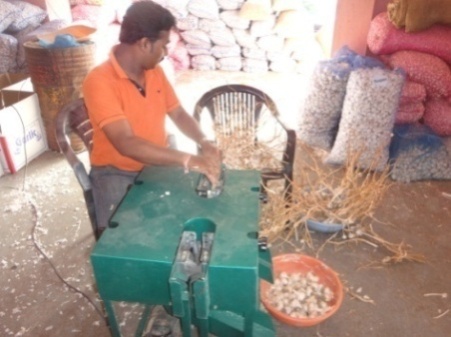 Power (0.75 kW electric motor) operated garlic stem and root cutter has been developed at MPUAT, Udaipur. It consists of main frame, feeding unit, clamping unit, cutting unit, power transmission unit and garlic bulb dropping chute. The feeding unit consists of two feeder box on opposite side of the machine to feed the garlic for cutting stem and root. The clamping unit is provided inside the feeder box to hold the garlic bulb and stem. The cutting unit consists of four pair of counter rotating root and stem cutters below each of the feeder box. The garlic bulb dropping chute is provided just below the cutting unit in such a way that garlic bulbs after cutting of root and stem collect in a tray. The mean output capacity with plain and serrated type cutters for one side of the feeder box is 33.89 kg/h and 33.15 kg/h, respectively. The mean cutting efficiency is 99.23, 99.14 and 98.90% for small, medium and large size garlic bulbs, respectively. The power requirement for cutting stem and root is 1.2 kWh.
Power (0.75 kW electric motor) operated garlic stem and root cutter has been developed at MPUAT, Udaipur. It consists of main frame, feeding unit, clamping unit, cutting unit, power transmission unit and garlic bulb dropping chute. The feeding unit consists of two feeder box on opposite side of the machine to feed the garlic for cutting stem and root. The clamping unit is provided inside the feeder box to hold the garlic bulb and stem. The cutting unit consists of four pair of counter rotating root and stem cutters below each of the feeder box. The garlic bulb dropping chute is provided just below the cutting unit in such a way that garlic bulbs after cutting of root and stem collect in a tray. The mean output capacity with plain and serrated type cutters for one side of the feeder box is 33.89 kg/h and 33.15 kg/h, respectively. The mean cutting efficiency is 99.23, 99.14 and 98.90% for small, medium and large size garlic bulbs, respectively. The power requirement for cutting stem and root is 1.2 kWh.

